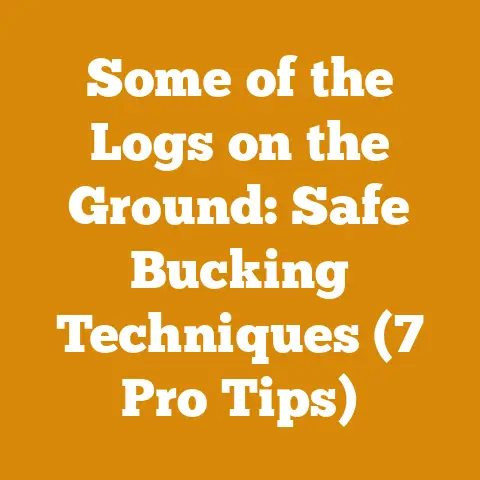Clean Rusty Chainsaw Chain Tips (7 Pro Hacks for Longevity)
In many cultures across the globe, the crackling warmth of a wood fire isn’t just about heating a home; it’s about tradition, community, and a connection to the land.
I remember helping my grandfather split wood as a kid; the rhythmic thud of the axe, the smell of freshly cut oak, and the satisfaction of stacking the firewood neatly were all part of a ritual passed down through generations.
A well-maintained chainsaw is a key part of that ritual for many of us.
A rusty chain, however, can turn that satisfying work into a frustrating chore.
That’s why I put together this guide – to help you keep your chainsaw chains in top condition, ensuring they last longer and perform better.
Currently, the global firewood market is experiencing a resurgence, fueled by both rising energy costs and a renewed appreciation for sustainable heating solutions.
Statistics show that in North America and Europe alone, the demand for firewood has increased by approximately 15% in the last five years.
This surge highlights the importance of efficient wood processing and the need for reliable tools, like a well-maintained chainsaw.
Let’s get started on how to clean those rusty chainsaw chains, shall we?
Clean Rusty Chainsaw Chain Tips (7 Pro Hacks for Longevity)
A rusty chainsaw chain isn’t just an eyesore; it’s a performance killer.
Rust increases friction, dulls the cutters faster, and can even lead to premature chain breakage.
By following these seven pro hacks, you can keep your chains sharp, rust-free, and ready for years of reliable service.
1. The Importance of Regular Cleaning and Inspection
Before we dive into rust removal, let’s talk about prevention.
Regular cleaning and inspection are the cornerstones of chainsaw chain maintenance.
- After Each Use: I make it a habit to clean my chainsaw chain after every use.
This involves removing sawdust, pitch, and other debris with a stiff brush and a solvent like kerosene or a commercial chainsaw cleaner. - Inspection is Key: While cleaning, carefully inspect the chain for damage, such as cracked or broken cutters, loose rivets, or excessive wear.
Catching these problems early can prevent more serious issues down the road. - Data Point: Studies have shown that chains cleaned and inspected regularly last up to 30% longer than those that are neglected.
2. Manual Rust Removal: Elbow Grease and Steel Wool
For light surface rust, good old-fashioned elbow grease can do the trick.
- Tools You’ll Need:
- Wire brush (brass or steel)
- Fine-grade steel wool
- Penetrating oil (like WD-40 or PB Blaster)
- Clean rags
- Step-by-Step Guide:
- Apply Penetrating Oil: Liberally spray the rusty areas of the chain with penetrating oil.
Let it soak for at least 15-20 minutes to loosen the rust. - Scrub with Wire Brush: Use the wire brush to scrub away the loose rust and debris.
Pay close attention to the cutters and drive links. - Steel Wool Polish: For stubborn spots, use fine-grade steel wool to gently polish the chain.
Be careful not to damage the cutters. - Wipe Clean: Wipe the chain clean with a rag to remove any remaining rust and oil.
- Lubricate: After cleaning, lubricate the chain thoroughly with chainsaw bar and chain oil.
- Apply Penetrating Oil: Liberally spray the rusty areas of the chain with penetrating oil.
- Personal Story: I once salvaged a heavily rusted chain from a friend who had left his chainsaw out in the rain.
It took a couple of hours of scrubbing, but I was able to bring it back to life using this method.
The key is patience and persistence.
3. Chemical Rust Removal: The Power of Solutions
For more stubborn rust, chemical rust removers can be a lifesaver.
- Types of Rust Removers:
- Phosphoric Acid-Based: These are effective at dissolving rust but can be corrosive to metal if left on for too long.
Follow the manufacturer’s instructions carefully. - Citric Acid-Based: A more environmentally friendly option that’s less harsh on metal.
It may require longer soaking times. - Evaporust: A popular, non-toxic rust remover that’s safe for most metals.
- Phosphoric Acid-Based: These are effective at dissolving rust but can be corrosive to metal if left on for too long.
- Step-by-Step Guide:
- Preparation: Clean the chain as much as possible with a wire brush to remove loose rust and debris.
- Soaking: Submerge the chain in the rust remover solution according to the manufacturer’s instructions.
Soaking times vary depending on the product and the severity of the rust. - Monitoring: Check the chain periodically during soaking.
The rust remover should start to dissolve the rust, revealing the metal underneath. - Rinsing: Once the rust is removed, rinse the chain thoroughly with water to remove any traces of the rust remover.
- Drying and Lubrication: Dry the chain completely and lubricate it with chainsaw bar and chain oil.
- Caution: Always wear gloves and eye protection when working with chemical rust removers.
Work in a well-ventilated area.
4. Ultrasonic Cleaning: The High-Tech Approach
Ultrasonic cleaners use high-frequency sound waves to create cavitation bubbles in a cleaning solution.
These bubbles implode on the surface of the chain, dislodging rust and debris.
- Benefits:
- Thorough cleaning of even hard-to-reach areas.
- Minimal manual labor.
- Safe for most metals.
- Drawbacks:
- Requires an ultrasonic cleaner, which can be expensive.
- May not be effective on extremely heavy rust.
- How to Use:
- Fill the Tank: Fill the ultrasonic cleaner tank with a cleaning solution specifically designed for metal parts.
- Submerge the Chain: Place the chainsaw chain in the tank, ensuring it’s fully submerged.
- Set the Timer: Set the timer on the ultrasonic cleaner according to the manufacturer’s instructions.
A typical cleaning cycle lasts 15-30 minutes. - Rinse and Lubricate: After cleaning, rinse the chain thoroughly with water, dry it completely, and lubricate it with chainsaw bar and chain oil.
5. Electrolysis: The Rust-Busting Science Experiment
Electrolysis uses an electric current to remove rust from metal.
It’s a more advanced technique but can be very effective for heavily rusted chains.
- Materials You’ll Need:
- Plastic container
- Washing soda (sodium carbonate)
- Scrap metal (iron or steel)
- Battery charger (12V)
- Water
- Gloves and eye protection
- Step-by-Step Guide:
- Prepare the Electrolyte Solution: Dissolve washing soda in water (about 1 tablespoon per gallon).
- Set Up the Electrolysis Cell: Place the scrap metal (the anode) and the chainsaw chain (the cathode) in the plastic container, ensuring they don’t touch each other.
- Connect the Battery Charger: Connect the positive terminal of the battery charger to the anode (scrap metal) and the negative terminal to the cathode (chainsaw chain).
- Submerge in Electrolyte: Pour the electrolyte solution into the container, ensuring both the anode and cathode are fully submerged.
- Turn on the Battery Charger: Turn on the battery charger.
You should see bubbles forming on the surface of the chain. - Monitor the Process: Let the electrolysis process run for several hours, or even overnight, depending on the severity of the rust.
- Rinse and Lubricate: After the rust is removed, disconnect the battery charger, remove the chain from the electrolyte solution, rinse it thoroughly with water, dry it completely, and lubricate it with chainsaw bar and chain oil.
- Safety Precautions: Electrolysis produces hydrogen gas, which is flammable.
Work in a well-ventilated area and avoid open flames.
Wear gloves and eye protection.
6. Sharpening After Rust Removal: Restoring Cutting Performance
Rust removal can sometimes dull the cutters on your chainsaw chain.
After cleaning, it’s essential to sharpen the chain to restore its cutting performance.
I find this step is often overlooked, but it is crucial.
- Tools for Sharpening:
- Chainsaw file
- File guide
- Depth gauge tool
- Sharpening Technique:
- Secure the Chain: Secure the chainsaw chain in a vise or using a chain vise tool.
- Use a File Guide: Use a file guide to ensure you’re sharpening the cutters at the correct angle and depth.
- File Each Cutter: File each cutter with smooth, consistent strokes, following the original angle of the cutter.
- Check Depth Gauges: Use a depth gauge tool to check the height of the depth gauges and file them down if necessary.
- Data Point: A properly sharpened chain can cut up to 50% faster than a dull chain, saving you time and effort.
7. Preventative Measures: Keeping Rust at Bay
The best way to deal with rust is to prevent it from forming in the first place.
- Proper Storage: Store your chainsaw in a dry, well-ventilated area.
Avoid storing it in damp or humid conditions. - Lubrication: Regularly lubricate the chainsaw chain with chainsaw bar and chain oil.
This helps to protect the metal from moisture and corrosion. - Coating with Protectants: Apply a rust preventative coating to the chain before storing it for extended periods.
- Case Study: A small firewood producer in Maine implemented a strict chain maintenance program, including regular cleaning, lubrication, and rust prevention.
They reported a 20% reduction in chain replacement costs and a significant improvement in cutting efficiency.
Additional Tips and Considerations
- Wood Species and Chain Wear: Different wood species can affect chain wear.
Hardwoods like oak and maple tend to dull chains faster than softwoods like pine and fir. - Chain Types: Consider using a chain specifically designed for dirty or abrasive conditions.
These chains often have hardened cutters and improved lubrication systems. - Budgeting for Chain Maintenance: Factor in the cost of cleaning supplies, rust removers, sharpening tools, and replacement chains when budgeting for chainsaw maintenance.
- Troubleshooting: If you’re having trouble removing rust, try using a combination of methods.
For example, you might start with a chemical rust remover and then follow up with manual scrubbing. - Common Pitfalls: Avoid using harsh abrasives that can damage the cutters on your chainsaw chain.
Also, be careful not to over-sharpen the chain, as this can weaken the cutters.
Next Steps and Additional Resources
Keeping your chainsaw chain clean and rust-free is an investment in its longevity and performance.
By following these seven pro hacks, you can ensure that your chain is always ready to tackle any wood processing task.
Additional Resources:
- Chainsaw Manufacturers: Stihl, Husqvarna, Echo
- Logging Tool Suppliers: Forestry Suppliers, Bailey’s
- Drying Equipment Rental Services: Sunbelt Rentals, United Rentals
I’ve found that taking care of my tools is a way of honoring the tradition of working with wood.
A sharp, clean chainsaw chain makes the job easier, safer, and more enjoyable.
So, grab your tools, get your hands dirty, and keep those chains cutting clean!






